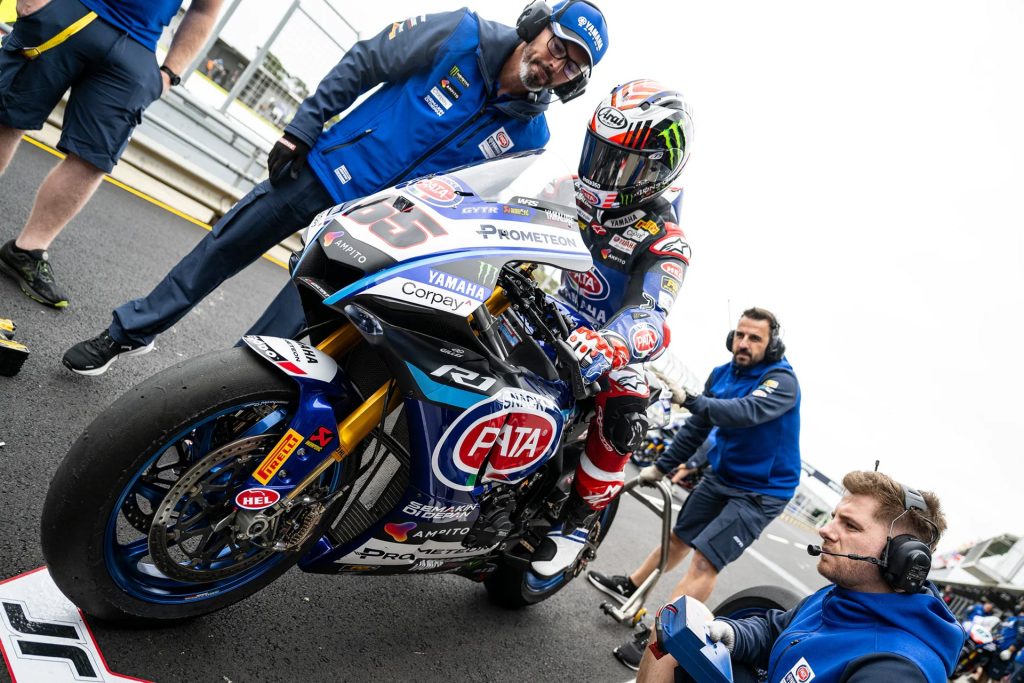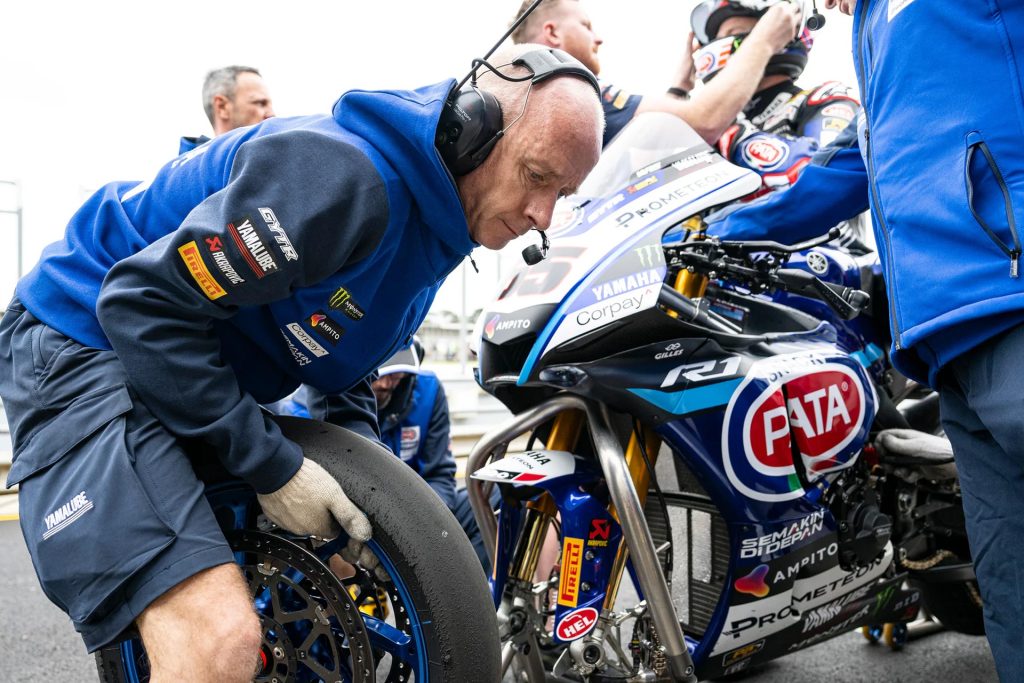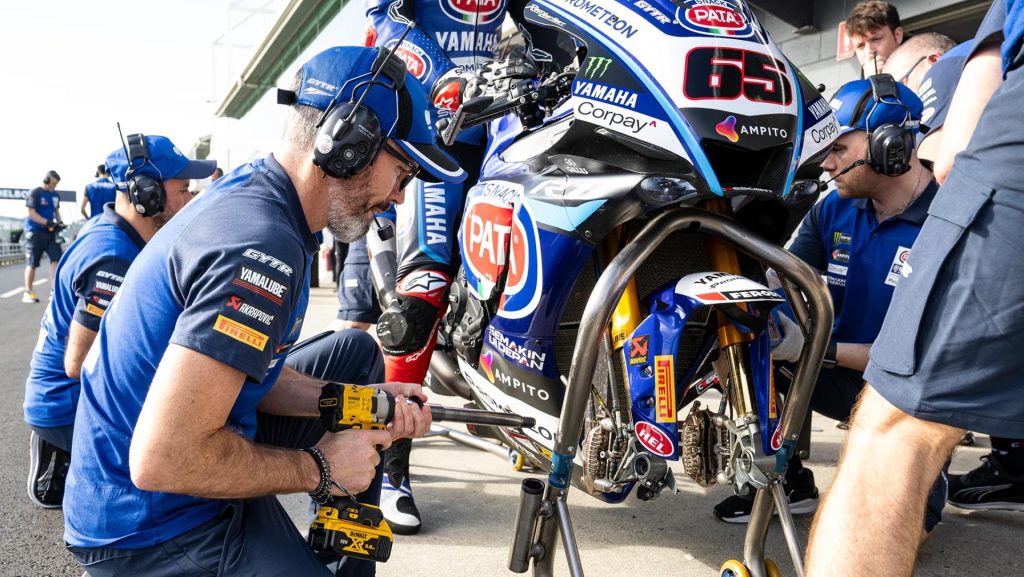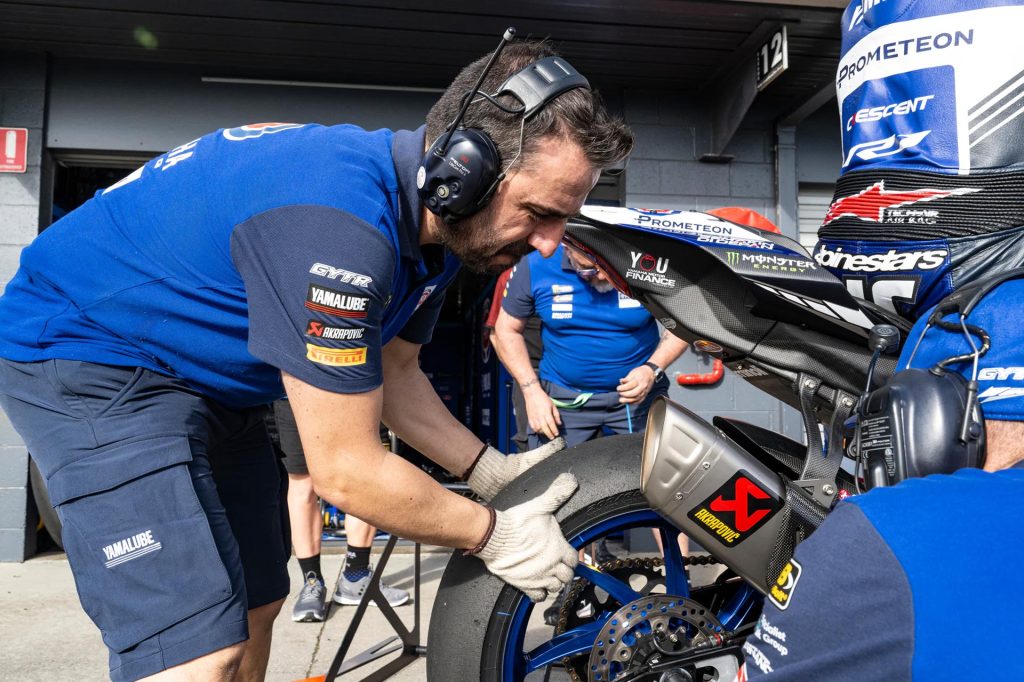WorldSBK 2024
Round One – Phillip Island
Pit Stops Explained
As if this weekend’s WorldSBK season opener in Phillip Island wasn’t already set to be exciting enough, an eleventh-hour curve ball was thrown at teams and riders on Thursday when it was announced that all feature races in both the Superbike and Supersport classes would require mandatory pit-stops.
Analysis of tyres used in Tuesday’s test by sole tyre supplier Pirelli, in conjunction with the FIM, determined that it may not be safe for riders to complete full race distance on Phillip Island’s “super grippy” and abrasive new surface. Therefore, it has been decided that a maximum of 11 laps can be completed on any one rear tyre.
In response to this, event organisers have reduced the distance of the weekend’s two feature WorldSBK races from 22 to 20 laps, with a mandatory pit stop between lap nine and 11 to change tyres to complete the race.
This adds a new dimension to teams’ planning and strategy from the very first practice session, as focus switches from how to be as clever as possible over 22 consecutive laps, to how to be as fast as possible over two 9-11 lap sprints.
In WorldSBK, riders only have one bike in the garage so pit stops are a busy but coordinated affair to change both the front and rear tyre, in a similar fashion to that seen in Endurance racing.
The most common reason for a pit stop is normally a sudden change of weather, meaning often many bikes will come into the pits at the same time. Similarly, in this weekend’s tyre and wheel change scenario, the riders will only have a three-lap window in which to briefly stop. Given the level of activity in pit lane, the differences between top and private teams and in the interest of overall safety, the rules state there is a minimum pit intervention time. This calculated time takes into consideration however long it takes a rider to get from one end of pit lane to the other on the pit speed limiter at 60kph, plus 30 seconds for a pit stop.

At Phillip Island for example, riders are given a 63-second pit intervention time. This is the minimum amount of time it must take from them entering pit lane, to leaving pitlane – a 549.2m distance, taking 33 seconds at 60kph. If the race machine transponder crosses the pit exit line any sooner than 63 seconds, then a rider is handed a penalty (five seconds for every second under the pit intervention time) – any later, then a rider is losing time in the race.
“The minimum time removes the pressure of having to be as quick as physically possible,” explains Jonathan Rea’s Crew Chief, Andrew Pitt. “Of course, speed is still important, but if we release the rider too early then we get penalised. We have 30 seconds for the pit stop itself, and usually we are able to complete it in less than 20 – so that leaves us 10 seconds to check everything is OK before getting the rider on their way.
“The key to a good pit stop is avoiding mistakes, as it’s when mistakes are made that things start getting held up.”
To ensure a pitstop is as efficient as possible, there’s a role for almost the entire team. Even the crew chiefs, and sometimes data engineers, are roped in on the tools to ensure a slick and effective stop with no-mistakes.
“While we can discuss various scenarios beforehand, ultimately it is the rider’s choice at what point they pit,” continued Pitt. “It all depends on where they are in the race, who they are battling with, how closely and what these riders do too. We as a team need to be prepared for the rider to come in when they decide.”
Usually, the team will know a pit stop is possible as in the case of this weekend, there is a specific time window where pit stops are possible (Laps 9-11) and in a race with changing weather conditions, race direction has to authorise bike changes before pit stops can be made.

The Crew Chief will ensure everyone is ready for a stop, and the first person to respond is the Tyre Technician who will take the new tyres from the tyre warming racks at the back of the garage and ensure they are ready at the front of the pit box – plugged in to the secondary warmer cables until the last possible moment to maintain optimal tyre temperature and pressure. Prior to the race, the team will have marked out their pitstop window in front of the box, including markers for where the rider should stop, plus where to place the relevant tools and equipment needed for a successful stop.
“As soon as we know a pit stop is possible, we have the tyres ready at the front,” explained Darryl Young, Andrea Locatelli’s Tyre Technician. “They’ll still be plugged into their warmers to keep their heat but we’ll loosen them slightly so they can be released from the warmer easily when the pitstop comes.”
The aim is for the team to be ready for a potential pit-stop as soon as the rider enters the final sector. A watchman will stand in pit lane with a lollipop style indicator to show the rider where their team are should they come in. As soon as this watchman spots the rider entering the pits, he informs the rest of the team via radio headset that the rider is almost upon them – but by this point, the team are already poised at the ready in a fully-synchronised group.
The rider then coasts into the designated markers in front of the box. Regulations state the engine must be turned off during the pit stop, so the rider will usually hit the kill switch as they roll into position.

Attention then turns to the team members at the front and rear of the R1 WorldSBK as they lift the bike onto its stands ready for the wheel change. In Jonathan Rea’s case, his Chief Mechanic Uri is responsible for the rear stand (and subsequent wheel change) and Mechanic Pete is responsible for the front. The second the bike is on its stands, the team members on the front and rear axles (Crew Chief Andrew (front) and Mechanic Tommy (rear) in JR’s case) use torque guns to remove the axle.
Once the axles are removed, attention turns back to the mechanics at the front and rear (Uri and Pete) who remove the wheels from the machine and are then handed the rims shod with new tyres, which they insert into the relevant end of the bike, ensuring the brake discs slot into the calipers and the chain is correctly placed onto the sprocket.
As soon as the wheels are in, the mechanics on the torque guns insert and tighten the axles in a single smooth movement before giving the front and rear brake a pump. As soon as everything is done, each mechanic will double check their own work, and also double check areas covered by the others.
“The extra 10-12 seconds is invaluable,” explains Pete Bancewicz (JR65 Mechanic). “Not only does it give you time to check your own work but it means you can all look over what everyone else has done before we release the rider when the 30 seconds are up.”

In a pit stop for a change in weather conditions, the team’s Öhlins engineer will also make tweaks to the front and rear suspension to improve the bike’s handling in the new conditions. In this weekend’s stops at Phillip Island, unless there is a weather change at the same point as the tyre stop, no changes will be made unless specifically requested by the rider.
While speed is not of the essence given the minimum pit intervention time, a smooth, timely pit stop allows the team more time to ensure overall safety of all aspects of the change and deliver the rider back into the thick of the race at full throttle – once they’ve crossed the pit exit line of course. While opinions on the format are mixed, it’s hard to deny the prospect of a “two-part” race isn’t exciting!
Phillip Island ASBK/WSBK Schedule
| Time | Class | Event |
| Saturday 24th February 2024 | ||
| 0705 | Timekeeping -Track System Test | Test |
| 0725 | FIM Medical Inspection /// FIM Track Inspection | |
| 0805 | Australian Superbike | Q |
| 0850 | Australian Supersport 300 | R2 |
| 0925 | Australian Supersport | R1 |
| 1000 | WorldSBK | FP |
| 1030 | WorldSSP | WUP |
| 1100 | Pit Walk 1 & Course Car Rides | |
| 1200 | Australian Superbike | R1 |
| 1300 | WorldSBK | Superpole |
| 1335 | Australian Supersport | R2 |
| 1430 | WorldSSP | R1 |
| 1505 | ASBK Pillion Rides | |
| 1600 | WorldSBK | R1 |
| Sunday 25th February 2024 | ||
| 0800 | Timekeeping -Track System Test | Test |
| 0830 | FIM Medical Inspection /// FIM Track Inspection | |
| 0910 | Australian Supersport 300 | R3 |
| 0945 | Australian Superbike | R2 |
| 1030 | WorldSBK | WUP |
| 1050 | WorldSSP | WUP |
| 1125 | Australian Supersport | R3 |
| 1155 | Pit Walk 2 & Course Car Rides | |
| 1300 | WorldSBK | SPRace |
| 1340 | Australian Superbike | R3 |
| 1430 | WorldSSP | R2 |
| 1505 | ASBK Pillion Rides | |
| 1600 | WorldSBK | R2 |
 2024 WorldSBK Dates
2024 WorldSBK Dates
| Date | Circuit | WSBK | WSSP600 | WSP300 | WWSBK |
| 23-25 Feb | Phillip Island | X | X | ||
| 22-24 Mar | Catalunya | X | X | X | |
| 19-21 Apr | Assen | X | X | X | |
| 14-16 Jun | Misano | X | X | X | X |
| 12-14 Jul | Donington | X | X | X | |
| 19-21 Jul | Most | X | X | X | |
| 9-11 Aug | Algarve | X | X | X | X |
| 23-25 Aug | Balaton Park | X | X | X | |
| 6-8 Sep | Magny-Cours | X | X | X | |
| 20-22 Sep | Cremona | X | X | X | |
| 27-29 Sep | Aragón | X | X | X | |
| 18-20 Oct | Jerez | X | X | X | X |























